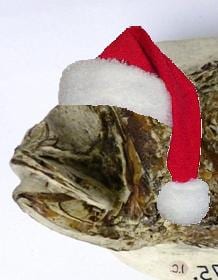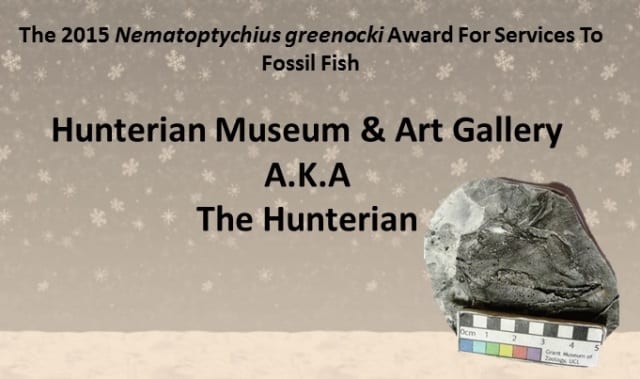Underwhelming Fossil Fish of the Month: December 2015
By Mark Carnall, on 23 December 2015
All is calm, all is poor(ly preserved).
Found yon fossil fish, maybe a skull.
Fragments of scales, so broken and dull,
Unidentified piece,
U-hun-identified piece.
2016 is nearly upon us, but before it is, let’s take some time to reflect on the highly disappointing year of underwhelming fossil fish that has passed. If this is your first dip into this blog series then you’re out of luck. This series is an exploration of the frankly dull and uninteresting fossil fish that are found in museum collections the world over. Are they destined to a…erm…. a destiny in a museum drawer? Yes probably. Are they justifiably destined to an eternity in a museum drawer though? Yes, probably. But this series aims to celebrate them because they’re underwhelming because life shouldn’t be all about biggest, brightest and boldest.
This year has been the least whelming year so far.
The year started off on an uncharacteristic handsome note and the much celebrated return of SPOT THE FOSSIL FISH for February. March was meh. April was all spikes and no trousers. May saw the series’ first ever official fan art and June was jazzy. July had an excitingly spoiled box. August saw fossil fish leaping from the water and allegedly glistening in the sun. September was silly, October was odious and nobody noticed November. Of course, we’re one fossil fish short of a full year and it brings me no joy to say that this one isn’t worth the wait. This month’s specimen isn’t even a genuine fossil! We’ve only had one entry so far that wasn’t the real deal and that was an awful cast back in March 2014. What worse way to round off the year, not with an underwhelming fossil fish but with an underwhelming rubber mould of a fossil fish?
I hope everyone is suitably underwhelmed for the end of 2015. This specimen is a rubber mould of Nematoptychius greenocki and according to the catalogue, this is a mould of a disarticulated skull. The mould has been washed with black to make some of the features stand out, let’s get a close up to see how that worked out.

Close up of LDUCZ-C151 Nematoptychius greenocki mould. The bit that looks like a black crab claw could be a jaw? There might be some teeth in there? There are two areas of textured surface one looks like hair, the other could be scales. To be honest, of all the underwhelming fossil fish of the month so far, this is the one that I can’t even confidently point to the fishy bit.
Given that it’s fairly impossible to identify this specimen from the mould alone, I’m going to controversially trust the label information*. Nematoptychius greenocki is a fairly obscure species, even compared to the species featured here previously. This species is a Palaeoniscid fish, an extinct family of fish so uninteresting that, at the time of writing, the Wikipedia page for this family is barely two lines long:
Palaeoniscidae is a family of fish who possessed a bony skeleton and operculum. This group of fish appeared in the Silurian, and died out in the Cretaceous.
So now you know.
Preservation It’s hard to tell from this cast what the preservation of the original is like, especially given that even one of the type specimens (a specimen used in the original description) of this species looks like this on the GB3D Type Fossil database. What’s interesting about this specimen (comparatively speaking) is that it’s a cast. In many natural history museums, casts, models and replicas are often treated as second-class specimens at best or not formally treated as specimens at all at worst. However, moulds and casts, even as poor and obscure as this specimen indicate at the very least that someone was interested in it enough at some point in time, to bother making a copy to study. Who was possibly interested in this specimen? Well that’s what the next section is all about.
Research There’s surprisingly very little about this species that’s been covered in the literature and contemporary taxonomic resources seem to disagree about who described it. Tantalisingly, a note in the database cites that the “original in PZS (1928), text fig 11, P60” which is zoological citation code referring to a Proceedings of the Zoological Society of London paper by our old friend D.M.S Watson. D.M.S. Watson was a former curator of the Grant Museum and a prolific palaeoichthyologist who quite literally wrote the book for the fossil fish groups that hadn’t previously been scrutinised. According to the database note the original specimen is figured in Watson’s 1928 gripping paper, On some points in the structure of palaeoniscid and allied fish. Frustratingly, however, I’ve not been able to find a readable copy of this paper to check the figure. The otherwise excellent Biodiversity Heritage Library only hosts digital copies of Proceedings of the Zoological Society of London as far as 1923 and the paper isn’t accessible here, at least within the Underwhelming Fossil Fish of the Month budget.
Unfortunately for the Grant Museum, Watson was also very ‘generous’ with his collection, giving specimens to other museums as well as taking his ‘personal’ collection with him from institution to institution. The P60 reference above could be a page number for the reference but Watson also used ‘P’ numbers for his specimens, however, it seems that P60 is no longer at the Grant Museum and the Sedgwick Museum at the University of Cambridge hasn’t digitised that part of the collection yet. Could this cast have been the one that Watson was looking at when he wrote the 1928 paper, one of the few papers focussing on this species? Does it make any difference if it was? No, probably not actually.
In Society Obviously, there’s nothing here for this section. I’d never heard of Nematoptychius greenocki, I’d wager you hadn’t and even within clandestine cabals of fossil fishologists it’s a niche beast. As there’s nothing to write here I’d like to skip the usual filler I write to…errr… fill this section for a festive message of love for the Hunterian Museum and Art Gallery collections database. No matter how obscure the fossil fish, without fail the Hunterian Museum and Art Gallery will have a specimen or two listed and for this species, it was pretty much the only part of the Internet to have ever mentioned Nematoptychius greenocki (side note: I’m not 100% unconvinced that this specimen isn’t the specimen that this is the mould of). Now this can mean one of two things. It could be that both the Grant Museum and the Hunterian Museum have specimens with hugely out of date taxonomy, hence the only museums that use these terms. Alternatively, it could be that the Hunterian, unlike many other natural history museums is the one that has made great strides to digitise their collections, including those specimens that other museums are afraid to such as underwhelming fossil fish. For that, I award the Hunterian the first ever Nematoptychius greenocki Award For Services to Fossil Fish. Thank you the Hunterian, I quite literally couldn’t do it without you, you are an inspiration to us all, particularly within the context of trying to find information about very underwhelming fossil fish.
Nematoptychius greenocki
Preservation 5
Research 2(possibly 7)
In Society 0
Underwhelmingness 8.5
*The first lesson you learn at museum curator school is, NEVER trust the label. It’s good advice for life in general.
Mark Carnall is the Collections Manager (Life Collections) at the Oxford University Museum of Natural History, and former Curator of the Grant Museum
One Response to “Underwhelming Fossil Fish of the Month: December 2015”
- 1
 Close
Close





[…] There’s a rather festive Underwhelming fossil fish of the month blog, complete with santa hat and palaeofied lyrics to a well known Christmas favourite, over on the Grant Museum of Zoology blog. […]